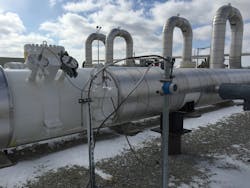You can’t take even a glance at the news lately without hearing about the hubbub going on with the Keystone XL pipeline. A Republican congress finally sees its chance to push through approval of the pipeline for TransCanada, while President Obama threatens to veto anything they pass.
Much of the focus in the debate is on environmental concerns (both with the pipeline and the extraction from Canada’s oil sands) on one side and the economic and employment benefits on the other. There’s plenty of misinformation being bandied about—as is typical with anything political—and I’m getting press information almost daily from TransCanada, trying to set the record straight on what the pipeline really means in terms of American jobs (Americans earned more than $2.7 billion in wages in Texas and Oklahoma alone from the building of the Keystone Gulf Coast Project, a section of the pipeline approved by Obama in 2012) and how much of the oil that travels down to the Gulf Coast then gets shipped to markets overseas (none).
But what I don’t understand is why more of the discussion isn’t focused on safety from TransCanada’s side. It’s pretty hard, from my perspective, to get onboard an argument about American jobs today being a good payoff for destroying our planet’s ecosystem for generations to come. But the safety argument is one that even staunch environmentalists ought to be paying attention to.
And I think TransCanada has a compelling story to tell. And guess what: It’s all about automation and control.
I reported a couple months ago about the Keystone pipeline after taking a tour of one of the pump stations in Stanton, Neb. So you can read here about some of the technical details of the motors, instrumentation and control center involved in the operation. But I think it’s worth bringing up the safety aspects of the proposed Keystone XL again.
In the interest of full disclosure, I’ll tell you that I’m a bleeding heart liberal who comes from a family of predominantly bleeding heart liberals. For several years before I leaped with both feet into the automation field, I covered the solar industry—still the manufacturing side, complete with nasty chemicals, but a green endeavor nonetheless that had a decidedly feel-good attitude running through everyone’s carbon-footprint-reducing veins. So when I told my mom that my new beat at Automation World would be continuous processing, which, these days, is predominantly oil and gas, she said, “Am I going to have to start boycotting you?” (As if she was reading my articles before…)
I remember hearing the words “Alaskan pipeline” when I was younger. The concept evoked images of denuded land and wildlife, and I was against it before I even bothered learning anything about it. But now the images I see are of exploding trains along the route from Canada or North Dakota.
As limitations have become more common on pipelines—like the limitations put on Keystone XL in the more than six years it’s been languishing in the approval process—transportation of oil and gas by rail and road has increased. Based on statistics from the U.S. Department of Transportation, which regulates the almost 500,000 miles of pipeline already existing in the United States, pipelines result in fewer spillage incidents and personal injuries than rail and road. In fact, according to the Manhattan Institute for Policy Research, trains are 3.5 times more likely to suffer safety lapses than pipelines are.
The Manhattan Institute has released a very thorough and detailed report that’s worth taking a look at to get a better understanding of pipeline safety, especially as it relates to other modes of moving petroleum products from one locale to another.
But it’s also worth realizing that there is much being done with Keystone XL in particular that should make it safer than other pipelines in the past. Because the Keystone XL extension has been planned from the ground up, it will be better equipped with the latest instrumentation and control systems.
The flow of the oil is regulated by variable-frequency drives, but it’s a failsafe system backed up by a pressure control valve. Three consoles at TransCanada’s oil control center in Calgary monitor the pipeline and pump stations. One console is dedicated entirely to monitoring the leak detection system (LDS). Two alternating satellites ensure that communication from the pump stations is never lost to any two stations in a row.
But perhaps most significant is the safety philosophy for Keystone. For example, the fact that a farmer can shut down the pipeline with just a single phone call if he sees anything of concern on his property is a significant change in philosophy from other pipelines, where operators did not want to cease the flow of petroleum products until they had investigated the issue. It’s not easy to shut down a batched system like the Keystone pipeline, but this was a significant lesson learned from incidents such as the burst pipeline and subsequent oil spill in Michigan’s Kalamazoo River in 2010, according to Corey Goulet, president of Keystone Pipeline.
The fact is that these products need to be transported from point to point somehow. Production of oil and gas in North America is going to continue to grow—with booming shale activities from North Dakota to Pennsylvania to Texas, and increasing offshore drilling. Pipelines are shown to be the safest way to transport those petroleum products.

